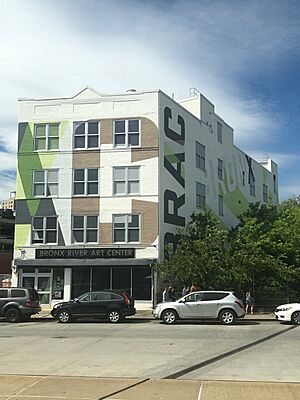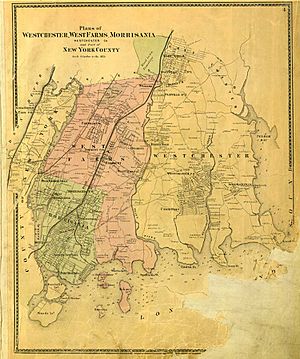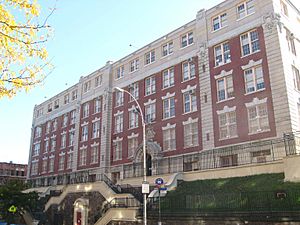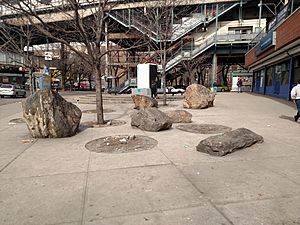West Farms, Bronx facts for kids
Quick facts for kids
West Farms
|
|
|---|---|
|
Neighborhood of the Bronx
|
|

Bronx River Art Center on Tremont Avenue
|
|
| Country | |
| State | |
| City | New York City |
| Borough | The Bronx |
| Community District | The Bronx 6 |
| Area | |
| • Total | 0.38 km2 (0.148 sq mi) |
| Population
(2011)
|
|
| • Total | 4,700 |
| • Density | 12,260/km2 (31,800/sq mi) |
| Economics | |
| • Median income | $35,423 |
| ZIP Codes |
10460
|
| Area code | 718, 347, 929, and 917 |
West Farms is a neighborhood in The Bronx, New York City. It's a place where people live and build their homes. The area is bordered by Bronx Park to the north and the Bronx River to the east. To the south, you'll find the Cross Bronx Expressway, and to the west is Southern Boulevard. The main street running through West Farms is East Tremont Avenue.
West Farms is part of Bronx Community Board 6. Its postal code is 10460. The local police department that keeps the area safe is the NYPD's 48th Precinct.
Contents
History of West Farms

West Farms used to be part of a larger town called Westchester, New York. In 1846, it became its own separate town. This new town included smaller settlements like West Farms, Morrisania, and Fordham. These places are still known as neighborhoods in The Bronx today.
The name "West Farms" comes from its history. It was the westernmost part of Westchester. In 1666, two people from Westchester, Edward Jessup and John Richardson, bought this land from the Native American owners. It was next to the "Broncke river," which we now call the Bronx River. Jessup passed away soon after, and his share of the land went to Thomas Hunt. The Hunt family is remembered in the name of Hunts Point.
During the American Revolution, many battles happened here. There weren't enough men to form a local army group, so West Farms and Fordham joined together to create one.
West Farms in the 1800s
In 1848, West Farms was described as a lovely village. It was located at the end of the Bronx River where boats could travel. It was about three miles from the East River and twelve miles from New York City. The village was growing fast, with about 1,000 people living in 200 houses.
The village had three public schools for boys and girls. There was also a special school for girls and a private school for boys. A train station for the Harlem & Westchester Rail Road was about a mile north of the village. Near the station, there were four churches, four taverns, and twelve different stores. There was also a post office.
The Bronx River was busy with seven sloops (a type of boat). West Farms also had factories. These included two carpet factories and a mill that ground grain and cut lumber. These mills used the power of the Bronx River.
Trains to New York City ran almost every hour. This helped West Farms grow into a popular place to live, much like Yonkers to its north. In 1848, the old Hunt house, built in 1688, was still standing on Hunts Point. The area was becoming dotted with beautiful homes. The famous poet Joseph Rodman Drake found inspiration here and is buried nearby. Some soldiers buried at West Farms Soldiers Cemetery on East 180th Street fought in the American Civil War.
Community Life in West Farms
West Farms is known for having a large Puerto Rican community. The neighborhood is a vibrant place with many families.
The 2010 United States Census showed that the population of West Farms-Bronx River was about 35,011 people. This was a small increase from the year 2000. The area covers about 344.72 acres.
The people living in West Farms come from many different backgrounds. In 2010, the population included:
- 26.6% African American
- 3.2% Asian
- 2.5% White
- 0.3% Native American
- 63.8% Hispanic or Latino
Most people in West Farms are young or middle-aged adults. About 29% are under 18, 28% are between 25 and 44, and 20% are between 45 and 64.
Buildings and Green Spaces
West Farms has many five and six-story apartment buildings called tenements. You can also find older multi-family homes and some newer townhouses and apartment buildings. The total area of West Farms is less than one square mile. The land is a bit hilly.
The West Farms Bus Depot is a large building where buses are stored and maintained. It opened in 2003 on East 177th Street.
There are also two NYCHA (New York City Housing Authority) buildings in West Farms:
- 1010 East 178th Street, which is a 21-story building.
- Twin Parks East (Site 9), which is a 14-story building.
Safety and Services
West Farms has its own New York City Fire Department (FDNY) fire station. It's called Engine Co. 45/Ladder Co. 58/Battalion 18 and is located at 925 East Tremont Avenue.
The United States Postal Service has a post office in West Farms. It's called the West Farms Station and is at 362 Devoe Avenue. The ZIP Code for West Farms is 10460.
Education in West Farms
Compared to other parts of New York City, West Farms has a lower rate of residents who have finished college. However, students in West Farms are improving in their studies. The percentage of elementary school students doing well in math went from 19% in 2000 to 44% in 2011. Reading achievement also increased during the same time.
Schools in West Farms
West Farms has several public and private schools for students of all ages.
Public Schools:
- PS 6: West Farms (East Tremont and Bryant Avenues)
- PS 66: School Of Higher Expectations (Jennings Ave.)
- PS 67: Mohegan (East 178th Street and Mohegan Avenue)
- JHS 98: Herman Ridder (East 173rd Street and Boston Road)
- CS 214: Lorraine Hansberry Academy (West Farms Road and East Tremont Avenue)
- Explorations Academy (East 173rd Street and Boston Road)
- Bronx Envision Academy (East 173rd Street and Boston Road)
- Wings Academy (East 180th Street and Bronx Park Avenue)
- Emolior Academy
Parochial School:
- St. Thomas Aquinas School (Daly Avenue)
Public Library
The New York Public Library has a branch in West Farms. It's located at 2085 Honeywell Avenue. This library first opened in 1929 and moved to its current spot in 1954. It's a great place for students to find books, do homework, and learn new things.
Transportation Options
Getting around West Farms and to other parts of New York City is easy thanks to many bus routes and subway lines.
Bus Routes
The following MTA Regional Bus Operations bus routes serve West Farms:
- Bx9: travels to Riverdale
- Bx19: goes to Riverbank State Park or New York Botanical Garden
- Bx21: connects to Westchester Square station or Third Avenue–138th Street station
- Bx36: travels to Castle Hill or George Washington Bridge Bus Terminal
- Bx40/Bx42: goes to Throggs Neck or Morris Heights
- BxM10: an express bus service to Midtown Manhattan
- Q44 SBS: travels to Jamaica, Whitestone, and Flushing
Subway Stations
The following New York City Subway stations serve West Farms:
- East 180th Street (2 5 trains)
- West Farms Square–East Tremont Avenue (2 5 trains)



